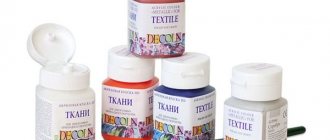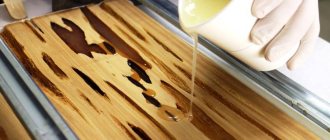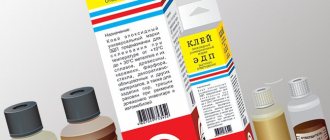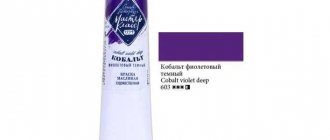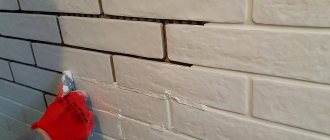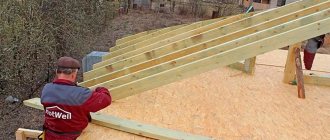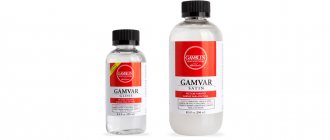If construction ends with finishing work - painting, then the renovation of a house or apartment is just beginning. The area of painting varies; it may include painting the floor, ceiling and walls, or it may be limited to one contrasting wall or only the floors. Naturally, while the paint is drying, you cannot use the painted surface, much less stay indoors. Therefore, many people have a question about how to quickly dry paint.
What is thinner for oil paints?
Thinners for oil paints and varnishes are used to reduce the viscosity of paints during work, and are also used to clean brushes, palettes and other tools. 2. White spirit – hydrocarbons of petroleum origin. ... Thinner No. 1 is a mixture of gum turpentine and white spirit in a 1:1 ratio.
Interesting materials:
How to connect Telegram to a computer? How to warm eggs? How to stay warm without heating? How to save balance 1s 8.3 in Excel? How to preserve basil in oil? How to preserve a bouquet in glycerin? How to preserve dahlias? How to preserve gladioli after digging? How to keep pears fresh for a long time? How to preserve pears at home?
How long does oil painting take to dry?
In general, to be more precise, oil paint does not so much dry as it hardens. Both the binder and the pigment take part in this process: paints prepared with polymerized oils form a film faster than paints prepared with regular, purified oils.
As a rule, such a film is formed in 5 days, a maximum of a week, but this will also depend on external factors. Complete hardening of the paint layer will not occur earlier than in six months.
What determines the drying of paint?
- On the temperature and humidity in the room where the painting is located. In a fairly dark and cool place, the painting does not dry for a long time, but if you move it to a room with a higher temperature and dry air, the process will go faster.
- You can also quickly dry oil paint on a painting painted with a thin layer - glaze. But works painted with thick layers of paint using the impasto technique will take longer to dry, and you will have to be patient.
- The thinner you use also plays a role. If it is, for example, linseed oil, then the painting will dry quite slowly, a week or even more. And if you use pinene, the paint will dry in a few days. By the way, any necessary solvent can be ordered in my store - https://nyshop.pro/product-category/solvents/.
- When choosing paint, remember that some pigments also affect drying. Titanium white, for example, takes longer to dry, but brown pigments dry faster.
I discuss all these and many other questions much more deeply in my FREE theoretical master class! There we will discuss painting equipment, the nuances of working with it and caring for it, painting techniques and much more. The master class is useful for both experienced artists and beginners
You can register here - https://nyschool.ru/reg_artmk?utm_source=seo&utm_medium=blog&utm_campaign=allseo
What is a tee in painting?
There is also a Thinner " Tee
"is a solution of linseed oil and varnish in turpentine.
Used for diluting artistic paints and varnishes. Tee
action : Varnish and oil neutralizes the loss of binder from paint (on “pulling” primers), thereby maintaining color intensity. Not suitable for thinning varnish.
Interesting materials:
How to refill an HP 652 cartridge at home? How to refill a lighter with gas at home? How to refuel to a full tank at Gazprom? How to refuel to a full tank at a gas station? How to register a house address? How to register a built house on a garden plot? How to make homemade wine ferment? How to make a house lily bloom? How to make violets bloom at home? How to make Fuchsia bloom at home?
When can a painting be varnished?
Once you have finished “washing” the painting, hang it somewhere for at least a day to dry. Only when it has dried thoroughly can you begin to varnish it. So, the paint on your painting has dried, and the painting itself, if you washed it, has dried. Now you can start coating the paint layer with varnish.
Interesting materials:
How long does it take to defrost meat in cold water? How long do irises last in water? How did Harry Potter breathe underwater? How does the salinity of ocean waters change? How does the salinity of water change from the equator to the poles? How will the ship's draft change when moving from water to sea? How to measure 1 gram of water? How to measure the volume of water in a tank? How to extract hydrogen from water? How do cacti survive without water?
What should you pay attention to?
Before you begin painting work, you should pay attention to several factors:
- First of all, the expiration dates of the paint, which must be indicated on the can.
- Instructions for use and dilution must be read clearly and in understandable language.
- Before use, the paint must be stirred most thoroughly, checking to see if there are any thickened components left at the bottom.
- The surface must be cleaned, degreased and primed.
- What is difficult to check is the storage conditions. When oil paint freezes, it can separate even after thorough mixing and lose its properties. But here the calculation is only on the conscience of the seller.
How to dry a painting faster
So, what needs to be done to make an oil painting dry faster:
- Firstly, you can use auxiliary substances and write your work right away with them. For example, pinene or tee added to the paint will speed up the drying time.
- Secondly, create a draft, make the room where the painting is drying more ventilated. Oil paint does not contain water, so the drying process does not depend on evaporation, but on the oxidation of the very paint film that eventually hardens. This is why fresh air is so important for the quick drying process of oil painting.
- Of course, you should also take into account the temperature that I mentioned earlier. If it is possible to place the painting near a heat source, do this and drying oil paints on canvas will be much faster.
Useful tips
Recommendations from experts that should be followed to quickly dry the tinting substance after application:
- It is necessary to add a drier to oil paint. It will speed up the drying process even when reapplying the composition.
- During renovations in a residential area, it is better to replace paint coatings with alkyd ones.
- Before painting, you need to warm up the room, since the tone applied in a cold room will quickly thicken in low temperatures, dry slowly and be difficult to distribute with a brush or roller.
- The thinner the paint layer, the sooner it will dry. If after this you can see translucent areas on the material, all painting procedures are repeated every other day.
- To avoid enamel oxidation, it is necessary to ensure constant air circulation in the room; it is better to artificially create a draft.
- The most favorable conditions are low humidity and high air temperature.
- Modern construction hair dryers have a separate function for drying paint. When using the device, it is important to avoid sudden temperature changes and bring it too close to the painted surface, since the applied layer may crack.
- Small parts coated with tone can be placed close to heating radiators or dried in the oven by selecting a special mode at a temperature of no more than 60 °C.
- An infrared heater will help dry a wall, ceiling or floor due to its ability to penetrate under the dye layer and heat it from the inside. The paint composition, spreading, is evenly distributed over the plane, so it dries in a matter of hours.
The problem of paint taking a long time to dry remains relevant. Quick-drying water-based solutions may not always be at hand, so you should follow certain rules to ensure that oil and other coatings dry quickly. The use of special catalysts and devices such as a hair dryer or infrared heater will significantly reduce the drying time. However, even in their absence, you can achieve the desired result by creating suitable conditions in the room.
Properties and features of modern paints
The modern market can offer many color options, but there are actually not so many types of paints, or rather their groups.
Quick-drying, water-based
These water-soluble dispersion paints dry in a matter of hours. They are readily used for both external and internal work; they are used to paint both concrete and brick with plaster. Such materials also have an advantage over other types of paints - environmental friendliness, because... they do not contain an organic solvent.
After drying, water-emulsion and water-dispersed mixtures do not form a dense vapor-proof film, which means that the walls and ceilings will “breathe.”
“Breathing” quick-drying coatings include not only water-based paint, but also latex, wallpaper and modern acrylic paint and enamel, the use of which produces quick and high-quality results.
Alkyd compositions
They are divided into phenolic, urethane, glypthal and pentaphthalic. The composition includes 5 main components:
- solvent solvent (turpentine or white spirit);
- filler (chalk or microtalc);
- functional additives – driers;
- red lead or ocher pigments, titanium white, etc.;
- varnish
Such paints are convenient and easy to apply to the surface; they are also suitable for any type of finishing, decorative and artistic work. The drying time of paint or varnish of this group is significantly reduced, however, such compositions still dry longer than acrylic water-dispersed emulsions.
If the composition contains specific-smelling solvents, it is still not recommended to use alkyd enamels indoors.
Oil paints
Repair and construction oil paints have the same composition of inorganic pigments, combined, alkyd drying oils and fillers as artistic oil paints that we see on the artist’s canvas (picture). You must not touch fresh canvases! Why? Because paints recently applied to canvas, and even in several layers, are easily deformed. The layers of paint need to dry thoroughly before the painting can be presented to the audience and critical judgement.
How long does oil paint take to dry? A very long time! She is generally a candidate for the title of champion in the “Paint Won’t Dry” category. And this is on the artist’s easel! What to do if the walls or floors of the house are covered with an oil-drying oil mixture? Luckily, there are options to speed up the drying of the sticky thick layer. Let's look at them below.
On video: how to choose paint.
Fast drying with added catalyst
The use of various paints and varnishes (including oil-based) that dry for a long time requires the use of special products that significantly accelerate the natural drying process. In this case, it is recommended to opt for driers, which are added to the composition strictly in accordance with the instructions supplied by the manufacturer.
How to speed up paint drying time
The champion in terms of drying time is oil paint. The surface painted with it can be used no earlier than after several days, which is a very long time. However, the process can be significantly accelerated if drying catalysts such as driers are used. These components do not affect the structure of the paint and the quality of the applied coating, but at the same time significantly reduce the drying time.
Catalysts are produced on the basis of metals such as cobalt, calcium, zinc and zirconium. Now on sale there are multi-metal driers that allow you to combine the advantages of several metals and deprive the finished product of a significant part of the disadvantages.
